The Different Types of Bollards and Their Uses
Leave a CommentWhat are bollards and what do bollards do?
Bollards are sturdy vertical posts used to control or restrict vehicular traffic, provide crowd control and security, and enhance the aesthetics of both architecture and landscaping. They come in a variety of shapes, sizes, and materials and are commonly found in public spaces, parking lots, and along roads and sidewalks. Altogether there are about 40 different types of bollard, ranging from conventional yellow steel bolt-down bollards to galvanized pipe that can be buried in the ground and enclosed in a plastic cover. This article outlines some of the most common types of bollard and their uses.
Fixed bollards
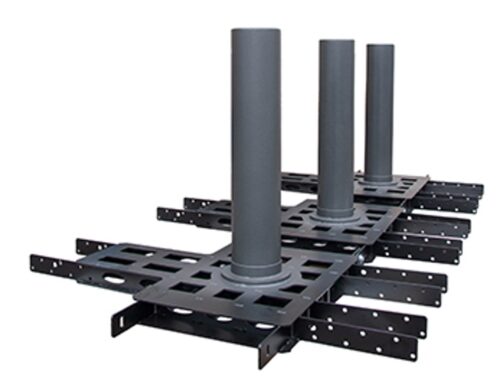
Fixed bollards are permanent traffic control posts. They are ideal for forming barriers around building entrances or parking lots and provide permanent collision protection and a visual deterrent for unwanted traffic. Usually made of steel or concrete, fixed bollards protect areas that no vehicles should ever access. Fixed bollards are available in both embedded and surface-mounted models, the former generally being more robust and the latter providing more flexibility with regards to usage. The picture above is an example of a shallow-mount array of fixed bollards.
Removable bollards
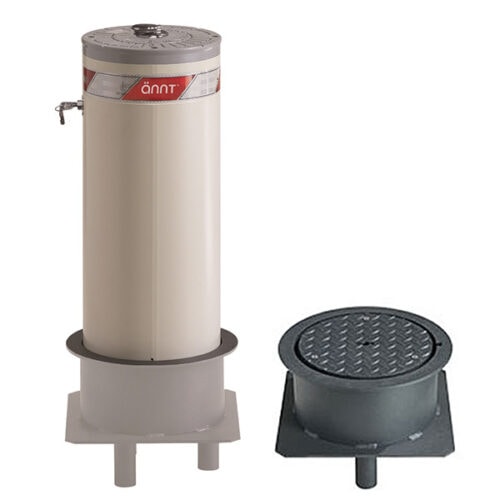
Removable bollards are designed to be easily removed and replaced when necessary. They are ideal for locations with changing access needs. Removable bollards are typically installed in a sleeve or socket set into the ground and can be taken out using a key or specialized tool. They are used in a variety of settings, including:
- Emergency access: To provide access for emergency vehicles when necessary, while still maintaining restricted access in normal conditions.
- Event management: To manage traffic and pedestrian flow during events such as festivals, concerts, or parades.
- Retail or business settings: To control access to parking lots or loading areas for delivery trucks.
- Seasonal changes: To restrict vehicles from areas that are only closed off during certain seasons, such as snow removal areas or summer patios.
Automatic Retractable bollards
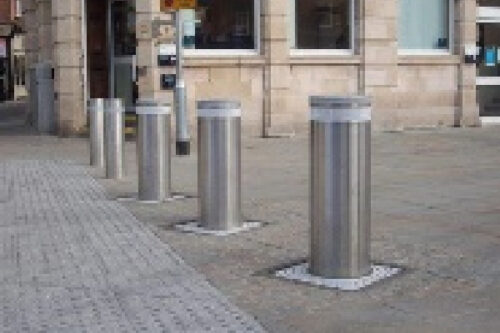
Automatic retractable bollards are a convenient medium to heavy-duty temporary barrier, as the bollards can be raised and lowered using an electromechanical or hydraulic operation method. These bollards can be operated with the push of a button, RFID card reader, or it can be easily integrated with existing control systems. Retractable bollards are an economical and flexible solution to reduce or redirect traffic to keep pedestrians safe. They are typically used in high-security areas or areas where frequent access is required, such as:
- Government and military facilities: To control access to secure areas such as military bases or government buildings.
- Public spaces: To manage pedestrian and vehicle traffic in spaces such as city centers, parks, and squares.
- Retail or commercial settings: To control access to loading docks or parking areas for delivery trucks.
- Emergency access: To allow emergency vehicles such as fire trucks or ambulances to pass.
Anti-terrorism bollards
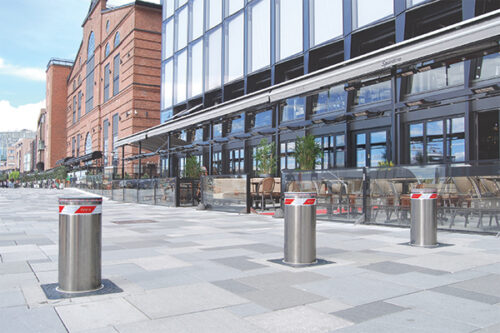
Anti-terrorism bollards are K-rated or M-rated bollards, designed and tested to stop a vehicle that is being driven at a certain speed. They can be fixed, removable or automatic. The “K” or “M” rating of a bollard refers to its ability to withstand impact from a vehicle traveling at a certain speed, measured in kilometers per hour (km/h) or miles per hour (mph). For example, a bollard with a K4 rating is designed to stop a vehicle weighing up to 6,800 kg (15,000 lbs) traveling at 50 km/h (30 mph), while a K12 bollard is designed to stop a vehicle weighing up to 6800 kg (15,000 lbs) traveling at 80 km/h (50 mph).
K-rated or M-rated bollards are commonly used in high-security areas such as government buildings, military bases, airports, and other critical infrastructure sites where protection against vehicle-borne threats is necessary.
Decorative bollards
Decorative bollards are designed to enhance the visual appeal of an area while still providing traffic control. They are often used in pedestrian areas, parks, and plazas. They come in a variety of shapes, sizes, and materials and can be customized to fit a specific theme or architectural style.
Illuminated Bollards
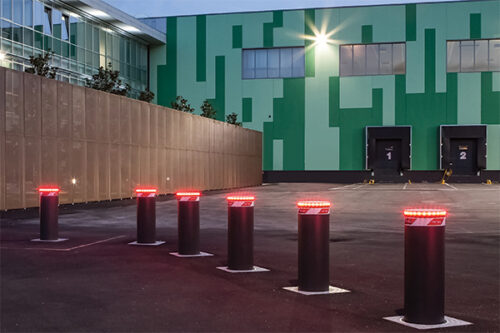
Illuminated bollards are decorative bollards that are equipped with lighting elements, such as LED lights, to provide illumination for outdoor spaces. These bollards are typically used to enhance the visibility and safety of pedestrian walkways, parking lots, parks, and other public areas.’
Flexible bollards
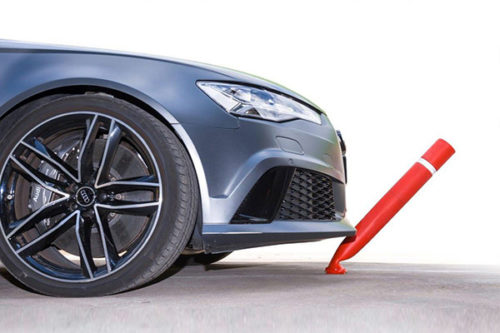
Flexible bollards are a type of traffic control device that is designed to bend or flex upon impact, instead of remaining rigid like traditional bollards. They are typically made of durable materials such as polyurethane, PVC, or rubber, and are often used to improve safety for pedestrians and cyclists.
Contact
Ontario Bollards specializes in the supply, servicing and installation of asset protection equipment and systems. With over 40 years of combined experience in the field, our knowledge of bollards and their applications is vast. Contact Ontario Bollards to help us help you.
The Importance of Proper Bollard Installation
Leave a Comment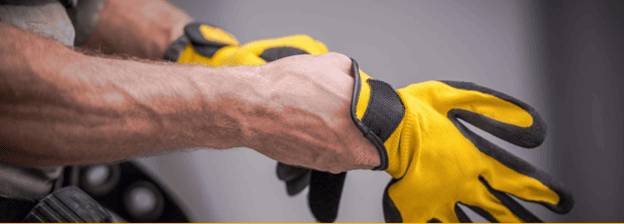
What are bollards?
Bollards are short, sturdy vertical posts that are often used to create a barrier or mark a boundary. They are typically made of metal, concrete or other durable materials and can be found in many different places, such as parking lots, sidewalks, and building exteriors. Bollards are commonly used to protect people and property from accidental collisions, such as when a vehicle veers off course or a bike rider loses control. They can also be used to prevent unauthorized access to certain areas or to guide traffic flow. Bollards can be installed individually or in a series.
There are many different types of bollards, such as fixed, removable or retractable (manual or automatic). And within these type categories there are various subtypes, including:
- Decorative bollards: Designed to enhance the aesthetic of an area
- Anti-terrorism bollards, or crash-rated (K-rated or M-rated) bollards: Designed to withstand high-speed collisions with vehicles, including car-ramming attacks by terrorists, a global issue that has recently become more prominent in Canada..
- Lighted bollards: Equipped with a built-in light source that illuminates the surrounding area, making it easier for people to see where they are going and to avoid potential hazards.
- Flexible bollards: Made from materials that bend and absorb impacts from vehicles, reducing damage and the risk of injury.
- Camera-equipped security bollards: Equipped with surveillance cameras, these bollards can be used to monitor and record activity in areas where security is a concern, such as parking lots, building entrances, and other public spaces. We don’t really carry camera-equipped bollards. I would take out this section.
Altogether there are about 40 types/subtypes of bollard providing a diverse range of functions. The world of bollards is much more multi-dimensional than most people realize!
Why proper bollard installation is so important
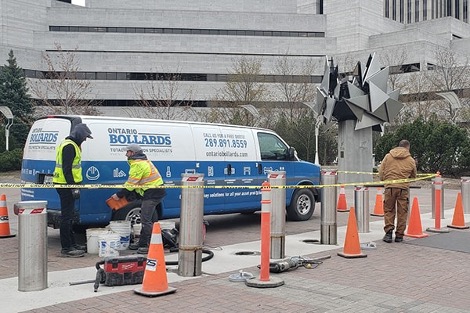
Proper installation of bollards is fundamental to any streetscape or landscape project where these fixtures are part of the plan. In fact, getting them installed is almost as important as choosing the right ones in the first place! Below are some key reasons why proper bollard installation is so critical.
- Safety: Bollards are often used to protect pedestrians, buildings, and other structures from vehicular traffic. Improperly installed bollards can become a safety hazard if they are knocked over or if they fail to stop a vehicle. Proper installation ensures that bollards are securely anchored and can withstand the intended level of impact.
- Durability: Bollards that are not installed correctly can become damaged or worn over time, reducing their effectiveness and longevity. Bollards must be installed using appropriate materials and methods to withstand weather conditions, wear and tear, and potential impacts.
- Functionality: Bollards are installed for a variety of reasons, such as controlling traffic flow, preventing vehicle access, and enhancing security. Improperly installed bollards may not serve their intended purpose, leading to ineffective or inefficient use of public space.
- Aesthetics: Bollards can be used to enhance the appearance of a property or to create a specific design element. Proper installation ensures that the bollards are installed in a way that is visually appealing and complements the surrounding environment.
- Liability: In the event of an accident or injury, improperly installed bollards can create liability issues for property owners and municipalities. Proper installation can help mitigate the risk of accidents and reduce liability.
It is important to follow industry standards and guidelines when installing bollards to ensure that they provide the intended level of protection and security. The best way to do this is to hire a professional with experience in bollard installation.
Contact
Ontario Bollards installs bollards virtually every workday of the year. Our reputation for doing the job right is unparalleled. Click here to learn more about Ontario Bollard’s installation services.
